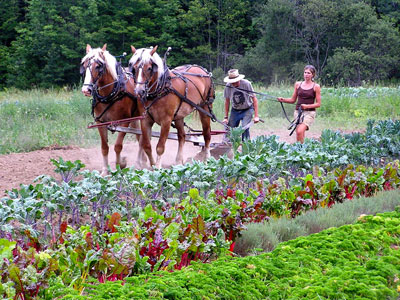 |
| Adrienne Lee and Ken Lamson farm to a new beat – with a combination of horse and human power. Photos courtesy of New Beat Farm. |
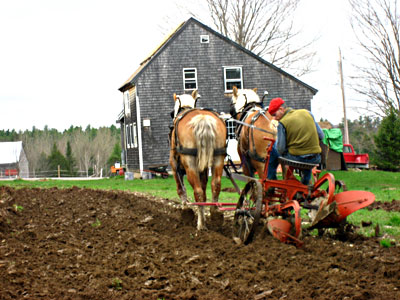 |
Young Farmers Integrate Horse Power into a Modern System
By Holli Cederholm
Farming with horses requires a different rhythm, attest Adrienne Lee and Ken Lamson while reflecting on the name of their New Beat Farm, now situated on 93 acres in Knox, Maine. Together Lee and Lamson cultivate 4 acres of certified-organic mixed vegetables, cut flowers and culinary herbs using a combination of horse and human power.
According to Lee, who had been working on tractor-powered farms for six or so years before starting a farm business with Lamson in 2008, choosing to farm with horses was a new beat in their lives. “It’s taking something that’s old and re-analyzing it into a new system.”
Lee and Lamson both grew up in Maine and shared an awareness of agriculture and interest in horses in their youth, but found farming as a livelihood through different trajectories.
Lee’s agricultural exposure included her parents’ vegetable garden, a childhood hobby of horseback riding, and high school employment as a landscape gardener. However, not until she attended the University of California at Santa Cruz, where she completed a degree in agroecology and sustainable agriculture, did Lee realize farming was a viable career option.
Upon graduation, Lee returned to Maine and began working at Goranson Farm, an organic diversified vegetable, meat and maple syrup farm in Dresden. Then Lee co-managed a 200-member summer CSA at Wolf Pine Farm in Alfred.
Lamson was landscaping and cooking in the Portland area when the two met and started pursuing farming together. His father was a dairy farmhand, exposing Lamson to working with both livestock and heavy machinery. “I grew up on a couple of different dairy farms,” he says. However he credits Lee with introducing him to vegetable growing.
“A lot of times I thought it was insane,” says Lamson about vegetable farming’s myriad aspects and the coordination and skilled labor it requires. Ultimately, though, he was both fascinated and excited by it. “I liked the energy of it.”
Gaining Draft Experience
In 2007 the two independently sought ways to familiarize themselves with draft horses. Lamson arranged a part-time apprenticeship with the now defunct Wildroot Farm in Kennebunk. “She [farmer Rachel Seemar] let me use the horses a lot and I got a lot of exposure,” he says.
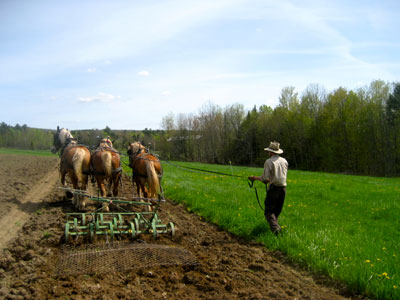 |
| Lamson harrows the ground in preparation for planting. |
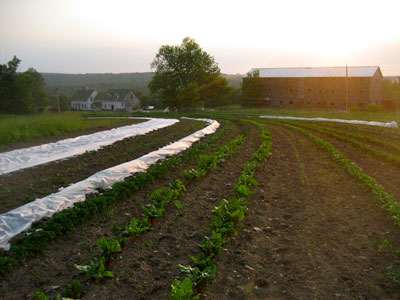 |
| Seedlings are transplanted outdoors, in rows far enough apart that Lee and Lamson can use horses for cultivation. |
Meanwhile Lee had decided she didn’t want to apprentice on another farm. “I knew a lot about vegetables but knew squat about horse power.” Instead she decided to work at horse-powered Willow Pond Farm in Sabattus. Lee joined MOFGA’s journeyperson program and selected horse farmer Earl “Mitch” Mitchell of Bowdoin as her mentor. Mitchell, who uses his team for row crops, hay and maple syrup, taught Lee how to plow and disc with horses in a field-based system.
Lamson was learning how to use the same implements at Wildroot, but with a different timing based on a mixed-vegetable market garden system.
After that season, the two decided to buy their own team of Amish-trained Belgians. “We realized we weren’t going to learn any more if we just didn’t start doing it ourselves,” says Lee.
They arranged a three-year lease on a parcel of land in Jefferson and kept off-farm jobs while they began working with their horses, which Lamson jokes knew more about how to work the fields than they did. “We had a year of transition, of working the kinks out,” he says. He also joined the journeyperson program at this time.
Farm Foundations
In 2009 Lamson and Lee officially kicked off New Beat Farm with the inaugural season of their primarily Portland-based 75-member CSA. “We needed a guaranteed market, so we put a fair amount of energy in Portland,” says Lee. Wolf Pine Farm was reducing its summer produce shares and referred a lot of its customers to New Beat. Lamson and Lee also joined farmers’ markets in Belfast and Damariscotta. (They now attend the Belfast and Orono markets.)
“As soon as we started doing Belfast, we started daydreaming about living in Waldo County,” says Lamson. The pair purchased farmland in Knox in 2010 after Maine Farmland Trust’s Farmlink program helped connect them with the property owners then, Glen and Edwin Larrabee. Of the total acreage, 38 acres are open – with 4 in certified organic vegetables and another 8 being transitioned from conventional (previously used to grow feed corn) to organic to allow for crop rotation. Roughly 26 acres are in pasture – used for a basic rotational grazing scheme – and the remainder consists of young hardwoods.
Their land stewardship principles and practices are determined by their ideals: to grow nutrient-rich organic food while at the same time improving their soil and minimizing their reliance on farm inputs from outside their bioregion. Lee says, “We want to work to be as self-sufficient as possible.”
“One of our long term goals,” says Lamson,” is to get away from buying in pallets of fertilizer and moving towards biodynamic preps and composts.” The horses provide a key source of soil fertility – manure. Lee and Lamson plan to add more livestock over time.
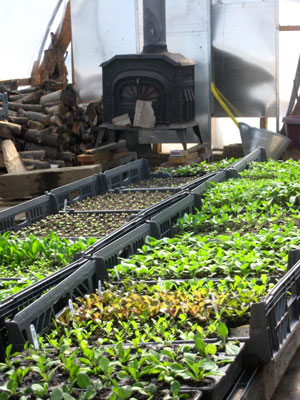 |
| Seedlings are started in a hoophouse. |
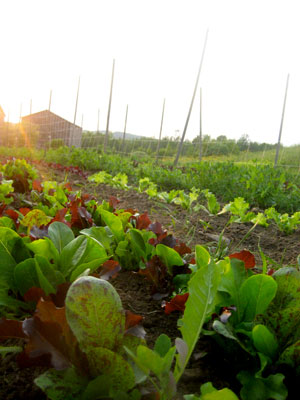 |
Another resource that New Beat is thinking about is oil. Lee says that farming with horses is one way to reduce dependence on fossil fuels; she notes that other farms use different strategies, including low-till management practices.
Lamson says, “We’re still relying on tractors to make our hay… you’re almost as connected to the petroleum chain.”
Lee adds, “We’re not against tractor power, but we’re choosing to rely on horse power. So we don’t want someone else’s tractor feeding our horses.” To that end, the two hope to hay a portion of their fields next season. “If we’re going to have animals, we’re going to try to grow their own food,” says Lamson.
Lamson reiterates what he tells apprentices: “You do not want to get horses just because of peak oil.” He really enjoys the slower pace of working with horses, as well as how quiet they are compared with tractors. Lamson also says he’s not super mechanically inclined. “To me, bone and muscle make a lot more sense than machines.”
Lamson says horses also set clear limits to work. “Working with horses constantly promotes an attitude in your farming of patience… it constantly humbles you,” says Lamson.
Horse farming requires a different level of attentiveness, says Lee. “Part of the reason I want to do horse power is because I want to add a level of awareness to farming.” Horses help her to better grasp an agroecosystem as she tunes into elements of farming beyond her own personal needs – such as pasture, weather and the animals’ energy levels.
Bio-Extensive Farming
A single farmer can’t tend hundreds of acres of corn with a horse and plow. Lee and Lamson think modern commodity-based agriculture has gotten too big, requiring massive tractors equipped with headlights and GPS navigation systems.
“So many farmers are out of scale, unbalanced because horses left the farm,” says Lamson. The scale “used to be kept in check by what a certain number of horses could do.”
Now there’s a new push to use horses in vegetable production, says Lamson. However, cultivating mixed vegetables with horses doesn’t make sense in smaller fields. Many market growers organize their fields for maximum crop yields from minimal land. For instance a grower might seed three rows of carrots to a 3-foot-wide bed, reducing space used but increasing the amount of human-powered cultivation, whether hand-weeding or stirrup-hoeing, necessary to maintain those crops. This exemplifies certain principles of a bio-intensive system, similar to systems that Eliot Coleman and John Jeavons have popularized.
Lee and Lamson model themselves heavily after Anne and Eric Nordell of Beech Grove Farm in Pennsylvania, who use a bio-extensive system. All crops at New Beat are planted in single rows, a single crop to a row, on a 36-inch center. (This margin varies slightly depending on the contour of the land.)
“Our paths are just big enough for the horses to get through,” says Lee. “This allows us to reduce the amount of hand weeding and increase the amount of horse cultivation we do. Unlike tractors, our horses require fuel, hay, and [they] care whether they are working or not. So by doing everything single row we are able to utilize them more.”
This system still emphasizes building soil fertility. At New Beat, crops are separated into early and late planting blocks to maximize cover cropping throughout the season. Early-season crops are harvested by the beginning of August and are followed by peas, vetch and oats.
In late-harvested crops, the wider pathways are inter-seeded with fall cover crops about four weeks after the crops are planted. “By having the pathways open, you can fill that whole pathway with cover crop before your crop is even finished,” says Lee. “By the time we pull our fall carrots and beets out in October, the rye and vetch we had seeded in the pathways has formed a thick mat, protecting the beds from erosion through the winter.”
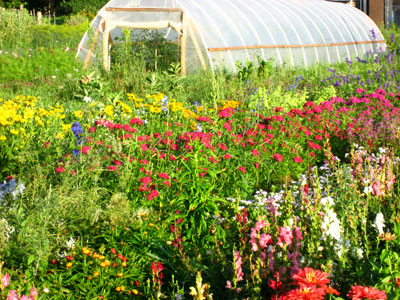 |
| In addition to certified-organic mixed vegetables and culinary herbs, New Beat raises cut flowers. |
They have an assemblage of standard pre-1950s horse-drawn implements: a moldboard plow, disc harrow, spring-tooth harrow, manure spreader, sickle-bar mower, and a straddle-row cultivator used to prepare beds, hill potatoes and do in-row weeding.
Also standard to New Beat’s horse-cultivated fields are 600-foot rows. “Rows are as long as possible,” says Lamson.
“Without deterring the apprentices,” adds Lee.
“That way you can actually get the horses into a rhythm, stepping nice,” says Lamson. “Now only if we can train them to harvest.”
